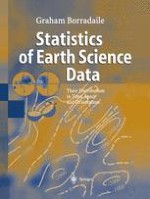2003 | OriginalPaper | Chapter
Spherical-Orientation Data
Author : Professor Graham Borradaile
Published in: Statistics of Earth Science Data
Publisher: Springer Berlin Heidelberg
Included in: Professional Book Archive
Activate our intelligent search to find suitable subject content or patents.
Select sections of text to find matching patents with Artificial Intelligence. powered by
Select sections of text to find additional relevant content using AI-assisted search. powered by
The previous chapter introduced the study of orientations that were constrained to lie in a plane, hence their shorthand name circular data. In nature, all orientations exist in three-dimensional space and the circular-orientation data that we collect in earth science are simply special cases whose angular distribution is controlled by the orientation of some planar feature in which they lie. For example, current directions on a bedding plane or the trends of vertical joints on a horizontal map projection may be represented without any important loss of information as lines on a plane. However, many geological and geophysical orientation data require specification in three dimensions. Therefore, each orientation requires three pieces of information to define its orientation. These may be the direction cosines of an axis or the x, y, z coordinates of the endpoint of a unit vector, or for that matter of a true vector.
